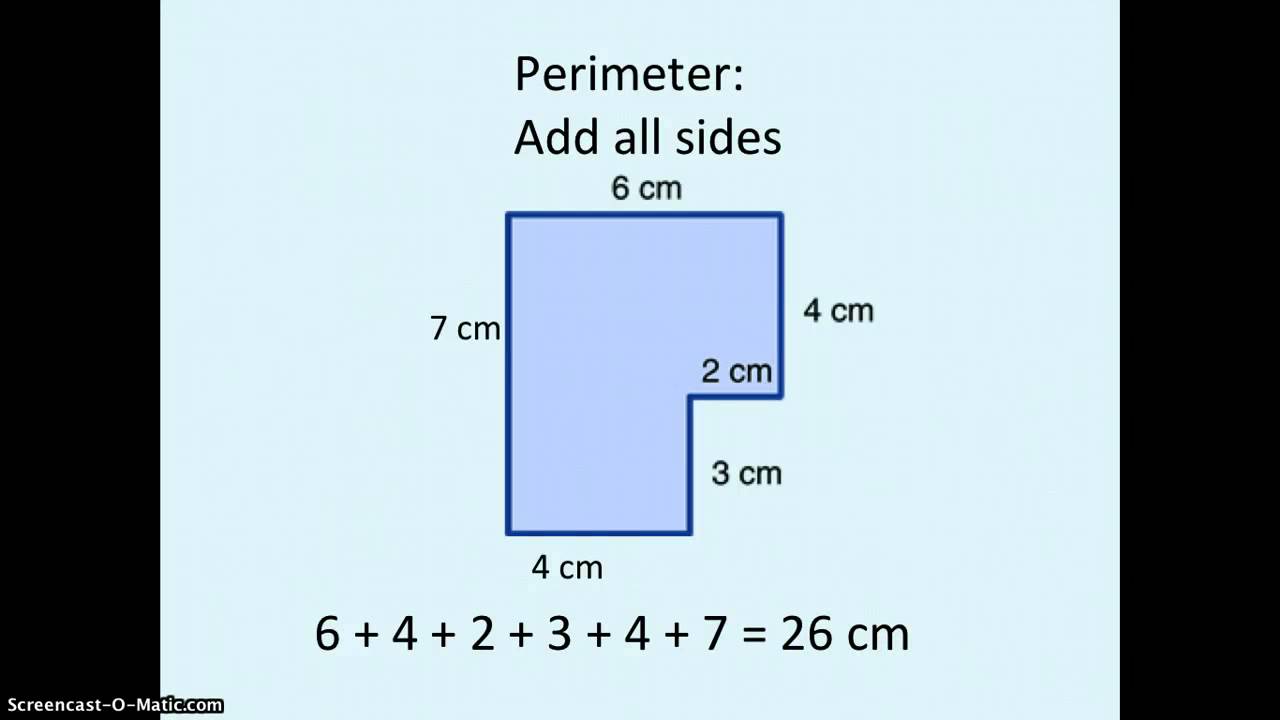
Understanding Area and Perimeter of Irregular Shapes
Interactive Video
•
Mathematics
•
6th - 10th Grade
•
Practice Problem
•
Easy
+3
Standards-aligned

Wayground Content
Used 13+ times
FREE Resource
Enhance your content in a minute
10 questions
Show all answers
1.
MULTIPLE CHOICE QUESTION
30 sec • 1 pt
What is the first step in finding the perimeter of an irregular shape?
Multiply the length by the width
Subtract the smallest side from the largest
Add up all the sides of the shape
Divide the shape into smaller shapes
Tags
CCSS.3.MD.D.8
2.
MULTIPLE CHOICE QUESTION
30 sec • 1 pt
How many centimeters is the perimeter of the given irregular shape?
24 cm
36 cm
26 cm
30 cm
Tags
CCSS.3.MD.D.8
3.
MULTIPLE CHOICE QUESTION
30 sec • 1 pt
What is the first step in calculating the area of an irregular shape?
Estimate the area visually
Multiply the longest side by the shortest side
Divide the shape into smaller, calculable shapes
Add all the sides together
4.
MULTIPLE CHOICE QUESTION
30 sec • 1 pt
Why are the measurements of seven and two crossed out in the example?
They are not needed for the perimeter calculation
They are errors in the measurement
They represent the shape's diagonals
They do not apply to the rectangles formed
Tags
CCSS.6.G.A.4
5.
MULTIPLE CHOICE QUESTION
30 sec • 1 pt
What is the purpose of dividing an irregular shape into rectangles?
To make it easier to visualize
To simplify the calculation of the perimeter
To simplify the calculation of the area
To reduce the number of sides to calculate
6.
MULTIPLE CHOICE QUESTION
30 sec • 1 pt
What are the dimensions of the top rectangle used to calculate the area?
Length 6 cm, Width 4 cm
Length 4 cm, Width 3 cm
Length 7 cm, Width 2 cm
Length 5 cm, Width 4 cm
Tags
CCSS.3.MD.C.7B
CCSS.4.MD.A.3
7.
MULTIPLE CHOICE QUESTION
30 sec • 1 pt
What is the area of the bottom rectangle?
12 square centimeters
24 square centimeters
18 square centimeters
14 square centimeters
Tags
CCSS.6.G.A.1
Create a free account and access millions of resources
Create resources
Host any resource
Get auto-graded reports

Continue with Google

Continue with Email

Continue with Classlink

Continue with Clever
or continue with

Microsoft
%20(1).png)
Apple
Others
Already have an account?
Similar Resources on Wayground

10 questions
Tes Diagnostik Matematika
Quiz
•
7th Grade

10 questions
Latihan Matematika (Keliling lingkaran)
Quiz
•
6th Grade

8 questions
Geometrija prostora i poliedri - zadatci s DM
Quiz
•
10th - 12th Grade

16 questions
Shapes
Quiz
•
6th - 8th Grade

10 questions
REPASO MATEMÁTICAS 3º No. 1
Quiz
•
9th Grade

15 questions
QUIZ Kelas 8 Sms 2 K13
Quiz
•
8th Grade

12 questions
Proportions and Ratios
Quiz
•
7th Grade

15 questions
Ratio & Proportion
Quiz
•
6th Grade
Popular Resources on Wayground

5 questions
This is not a...winter edition (Drawing game)
Quiz
•
1st - 5th Grade

15 questions
4:3 Model Multiplication of Decimals by Whole Numbers
Quiz
•
5th Grade

25 questions
Multiplication Facts
Quiz
•
5th Grade

10 questions
The Best Christmas Pageant Ever Chapters 1 & 2
Quiz
•
4th Grade

12 questions
Unit 4 Review Day
Quiz
•
3rd Grade

10 questions
Identify Iconic Christmas Movie Scenes
Interactive video
•
6th - 10th Grade

20 questions
Christmas Trivia
Quiz
•
6th - 8th Grade

18 questions
Kids Christmas Trivia
Quiz
•
KG - 5th Grade
Discover more resources for Mathematics

10 questions
Identify Iconic Christmas Movie Scenes
Interactive video
•
6th - 10th Grade

15 questions
Solving Equations with Variables on Both Sides Review
Quiz
•
8th Grade

15 questions
scatter plots and trend lines
Quiz
•
8th Grade

21 questions
Convert Fractions, Decimals, and Percents
Quiz
•
6th Grade

20 questions
Solving Systems of Equations by Graphing
Quiz
•
8th Grade

20 questions
Exponents
Quiz
•
6th Grade

20 questions
One step Equations
Quiz
•
6th Grade

15 questions
Christmas Movie Trivia
Quiz
•
7th Grade
